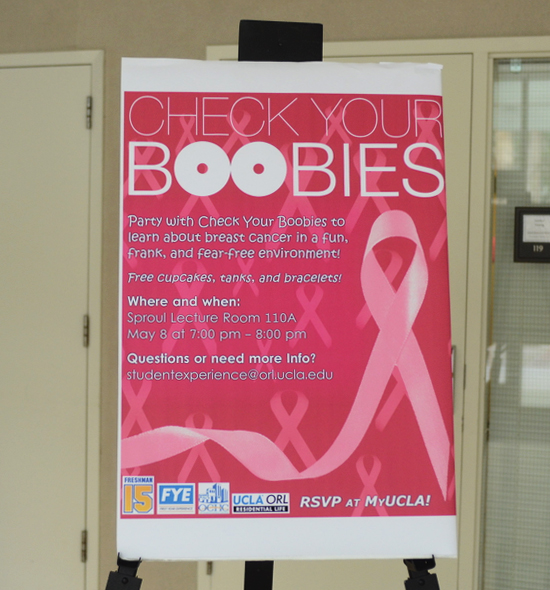Katie Shepherd: Campaigns should avoid sexual approach

A poster stands in Sproul Hall, advertising a May 8 event coordinated by breast cancer educational organization Check Your Boobies and the First Year Experience office at UCLA.
By Daily Bruin Staff
May 6, 2013 11:40 p.m.
Heart disease is the No. 1 killer of women in America. Cancer takes second place. And while breast cancer comes in second in that category, it receives among the most publicity and research funding of any health issue in America.
Moreover, breast cancer is one of the only diseases consistently sexualized by awareness campaigns. Sexualized marketing is commonplace to gain visibility in a sea of awareness and education organizations, especially when college-aged people are the target audience.
Now this rhetoric has arrived on campus. On Wednesday, the First Year Experience office at UCLA will team up with Check Your Boobies, a breast health educational organization that uses a similar tactic of capitalizing on suggestive language and imagery to draw in young people.
Check Your Boobies’ flyers bear the word “boobies” with breasts clearly depicted within the “O”s, intentionally drawing attention by playing off the taboo of seeing breasts in public spaces.
The use of sexual rhetoric to promote an important cause refocuses discussion of breast cancer on breasts themselves rather than women with the disease.
Though this language generates interest, it can damage the body image of women whose breast cancer may result in a mastectomy and can also take away from serious discussions of the disease.
The arguments against using this advertising strategy have been made before, especially during National Breast Cancer Awareness Month in October. With an event on campus using this racy advertising to engage younger audiences, they are especially relevant now.
“I love boobies!” bracelets and shirts printed with “Save the Ta-Tas” exemplify this principle, drawing attention through a focus on the provocative depictions of breasts rather than images of women diagnosed with or recovering from breast cancer.
To be sure, Check Your Boobies’ strategy to draw young women to its educational events has been supremely successful – 17,000 women have attended their events to date, according to Heike Malakoff, founder and executive director of the organization. Educating so many young women about breast health speaks to the admirable influence the organization has on college campuses.
Check Your Boobies aims to inspire young women to be proactive about their own health and advocate for themselves, Malakoff said.
“(The logo) needs to be catchy and it needs to be fun and sort of shock people,” Malakoff said. “You want people to look at it and take note of it.”
While some might argue that any campaign that succeeds in bringing attention to breast cancer is a worthy one, flashy marketing shouldn’t be the only goal of an organization’s name and logo. The subtle messages behind those representations need to be considered carefully.
The intentions of the logo and name are innocent enough, but good intentions don’t absolve the organization of treading the line between playful and harmful.
The emblem certainly demands notice. Yet, these kinds of shock-inducing campaigns place little faith in young people’s ability to be proactive and take interest in an issue without being lured in by a catchy slogan or racy logo.
Many organizations manage to advertise to young audiences successfully without using distracting slogans to draw them in. Relay for Life, which held a fundraiser at Drake Stadium on Saturday, is a prime example of successful marketing that doesn’t rely on suggestive language to draw in young supporters.
Drawing people to Relay for Life can be difficult, but doing so without using provocative marketing to lure people in ensures that participants are invested in the cause and makes Relay for Life events more effective, said Sogol Ashrafian, a fourth-year human biology and society student and education chair for Relay for Life at UCLA.
Because Relay for Life advocates for cancer awareness in general, it exemplifies the principle that breast cancer awareness and educational organizations should not have to resort to sexual rhetoric to gain support.
The intent behind Check Your Boobies’ playful approach is to foster a frank and fearless environment for the discussion of breast health, said Kayla Driscoll, program manager for the organization. Certainly, throwing “parties” to educate women brings a sense of fun to a serious topic that may be off-putting for many young men and women.
Removing the taboo from breast cancer is a goal that merits attention, but the current campaign unfairly assumes that young men and women will not care if they are not catered to with suggestive terms and pictures.
One in eight women is diagnosed with breast cancer during her lifetime. We all have women that we care about in our lives, so therefore we have motivations for investing our time in seeking breast health education without sexualized advertising.

